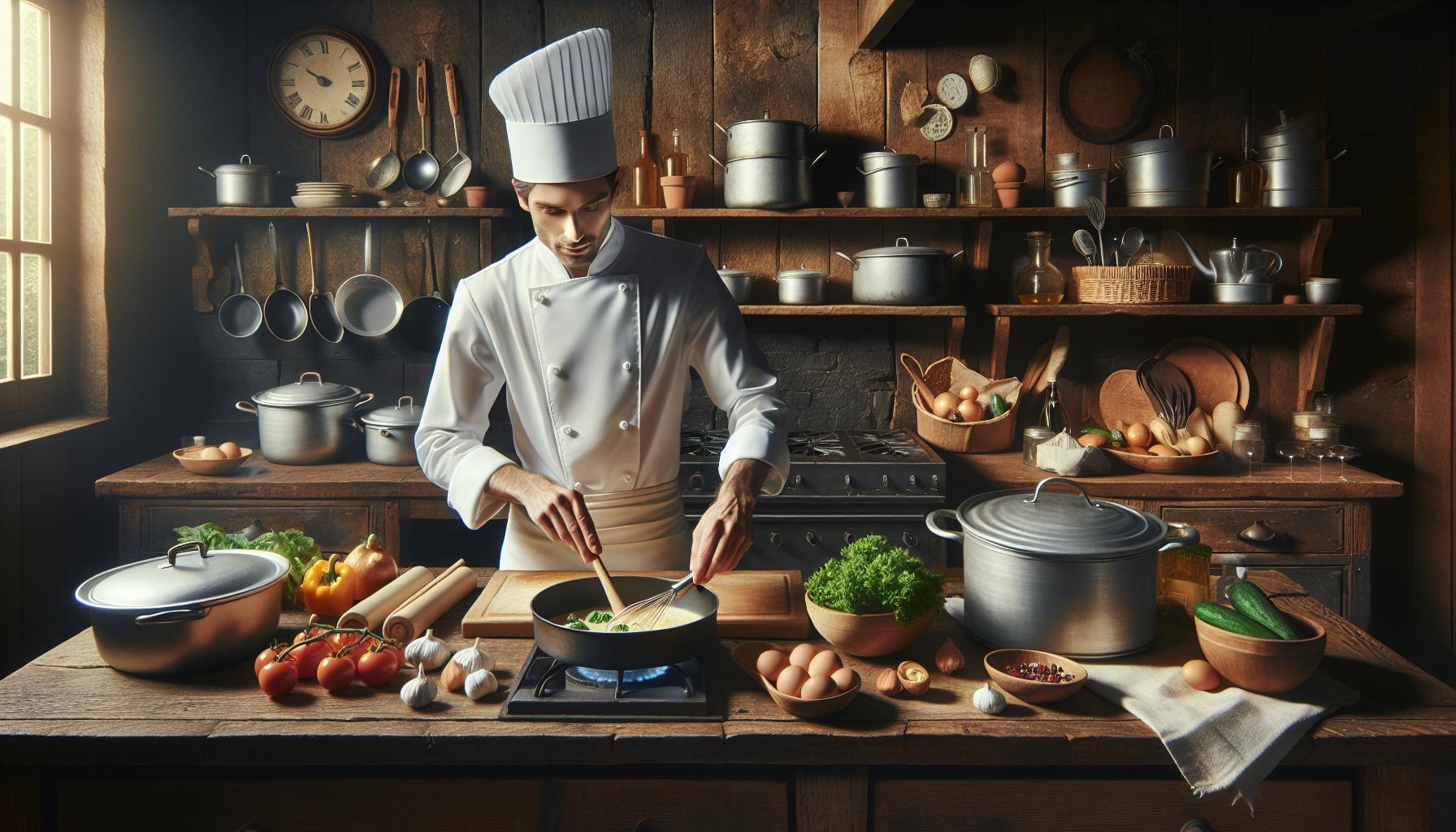French cuisine isn’t just about fancy plates and complicated names – it’s a way of life that has captivated food lovers worldwide for centuries. From the moment fresh croissants hit neighborhood bakeries at dawn to the last sip of wine at dinner, French food culture orchestrates a daily rhythm that transforms eating into an art form.
At its heart, French gastronomy reflects a deep-rooted passion for quality ingredients, time-honored techniques and the pure joy of sharing meals with loved ones. It’s no wonder UNESCO recognized French culinary traditions as an Intangible Cultural Heritage of Humanity. While other cultures eat to live, the French truly live to eat – turning every meal into a celebration of flavors, textures and social connections that define their national identity.
French Food Culture
French cuisine emerged from diverse cultural influences spanning centuries of culinary evolution. The foundations of modern French cooking techniques trace back to medieval times, with significant refinements during the Renaissance period.
Regional Influences on French Cooking
Each French region contributes distinct flavors to the national cuisine based on local ingredients availability. Normandy specializes in dairy-based dishes with apple ingredients, while Provence features Mediterranean elements like olive oil herbs tomatoes. The Alsace region incorporates Germanic influences, producing distinctive dishes such as choucroute garnie tarte flambée. Burgundy developed rich wine-based sauces coq au vin boeuf bourguignon, reflecting its renowned vineyards. Brittany’s coastal location spawned seafood specialties like moules marinières galettes bretonnes.
Historical Evolution of French Gastronomy
Medieval French cooking centered around preserving food using salt spices. The Renaissance period introduced Italian refinements through Catherine de Medici’s influence in the 16th century. Chef La Varenne established fundamental cooking principles in 1651, publishing the first French cookbook featuring roux-based sauces. The French Revolution dispersed royal chefs throughout Paris, creating the first restaurants. Auguste Escoffier modernized kitchen organization in the 19th century, developing the brigade system. Marie-Antoine Carême elevated French cuisine to an art form, creating elaborate presentations grand sauces that define haute cuisine today.
Essential Elements of French Food Culture

French food culture embraces specific customs centered around meal preparation presentation methods refined over centuries. The culinary experience extends beyond taste incorporating elements of timing ceremony visual appeal.
The Multi-Course French Meal Structure
A traditional French Food Culture follows a structured sequence that enhances the dining experience. The meal starts with an apéritif – a light alcoholic beverage served with small bites (amuse-bouches). The entrée (starter) introduces delicate flavors through dishes like soupe à l’oignon or pâté. The plat principal features a main protein accompanied by vegetables or grains. A cheese course (fromage) presents 3-4 varieties arranged from mildest to strongest. The dessert concludes the meal with sophisticated creations like crème brûlée or tarte tatin. Each course serves a specific portion size allowing diners to appreciate every dish fully.
Wine and Food Pairing Traditions
French wine pairing focuses on enhancing flavors through strategic combinations of food and wine. Red wines complement red meats hearty stews aged cheeses while white wines pair with seafood poultry light sauces. The Loire Valley’s Sauvignon Blanc matches perfectly with local goat cheese. Burgundy’s Pinot Noir elevates dishes with mushrooms earthy flavors. Champagne serves as an ideal companion to oysters delicate seafood. Regional wine traditions dictate specific pairings: Alsatian Riesling with choucroute garnie Bordeaux reds with lamb dishes Provence rosés with Mediterranean cuisine. Sommeliers in French restaurants guide diners through these pairings ensuring optimal flavor combinations.
Social Aspects of French Dining

French dining culture centers on social connections through shared meals. The French approach to dining emphasizes conversation connection and communal enjoyment of food.
Family Meals and Dining Etiquette
French family meals follow specific customs that reinforce social bonds. Children learn proper table manners from an early age including sitting up straight placing napkins on laps keeping elbows off the table. Meals last 45-60 minutes with family members discussing their day school work or current events. The host serves women first followed by men then children with bread placed directly on the tablecloth not on plates. Traditional etiquette dictates keeping both hands visible on the table crossing utensils to signal completion of a course waiting for everyone to begin eating together.
Cafe Culture and Restaurant Customs
French Food Culture cafes serve as social hubs where patrons linger for hours over coffee espresso or wine. Restaurant dining involves multiple unspoken rules such as greeting staff with “Bonjour” upon entering waiting to be seated by the host making reservations for dinner service. Servers maintain a professional distance approaching tables only when signaled allowing diners to enjoy conversations without interruption. Typical cafe visits last 90-120 minutes with customers occupying the same table through multiple coffee refills or meal courses. Standard restaurant tipping ranges from 5-10% as service charges appear automatically on bills.
| French Dining Time Customs | Duration |
|---|---|
| Family Dinner | 45-60 minutes |
| Cafe Visit | 90-120 minutes |
| Restaurant Service | 2-3 hours |
Traditional French Cooking Techniques

French culinary techniques form the foundation of professional cooking worldwide. These methods emphasize precision timing mastery of fundamental skills.
Classical Mother Sauces
The five mother sauces anchor French cuisine through their versatility and flavor complexity. Béchamel combines milk with roux for a creamy white sauce. Velouté uses light stock with roux as its base. Espagnole transforms brown stock into a rich brown sauce. Hollandaise blends egg yolks with clarified butter through emulsion. Tomato sauce incorporates aromatics with fresh or preserved tomatoes. Each mother sauce creates dozens of derivative sauces:
| Mother Sauce | Key Ingredients | Popular Derivatives |
|---|---|---|
| Béchamel | Milk, roux | Mornay, Soubise |
| Velouté | Light stock, roux | Allemande, Supreme |
| Espagnole | Brown stock, mirepoix | Demi-glace, Bordelaise |
| Hollandaise | Egg yolks, butter | Béarnaise, Maltaise |
| Tomato | Tomatoes, aromatics | Provençale, Marinara |
- Sautéing (sauté) in a shallow pan over high heat
- Braising (braiser) for tender meat dishes
- Poaching (pocher) for eggs fish vegetables
- Flambéing (flamber) with alcohol
- Roasting (rôtir) for caramelized exteriors
- Confit cooking in fat at low temperatures
Modern French Food Culture
French culinary traditions blend time-honored practices with contemporary innovations. The modern French food scene maintains its cultural identity while adapting to changing global influences.
Contemporary Dining Trends
Modern French dining embraces fusion cuisine that combines traditional techniques with international flavors. Restaurants incorporate plant-based options alongside classic meat dishes to accommodate diverse dietary preferences. The rise of bistronomy movements merges haute cuisine quality with casual dining atmospheres at lower price points. Digital platforms transform restaurant reservations making fine dining more accessible to younger generations. Food markets feature artisanal producers who create updated versions of classic French products like gluten-free croissants organic cheeses sustainable wines.
Preserving Culinary Heritage
French culinary institutions safeguard traditional cooking methods through structured apprenticeship programs. The Meilleurs Ouvriers de France competition recognizes exceptional craftspeople who maintain exacting standards in food preparation. Regional food festivals celebrate local specialties such as Burgundy’s wine harvest festivals Brittany’s oyster fairs Provence’s olive oil celebrations. Cooking schools throughout France teach classic techniques to international students ensuring the transmission of French culinary expertise. Government initiatives protect traditional food products through appellations d’origine contrôlée certifications maintaining authentic production methods for items like champagne roquefort cheese brie de meaux.
French food culture stands as a testament to the nation’s dedication to culinary excellence and social connection. The intricate blend of traditional techniques modern innovations and regional specialties continues to shape global gastronomy while preserving centuries-old customs.
From the morning café ritual to elaborate dinner services French cuisine remains a vital expression of cultural identity. Its influence extends far beyond France’s borders inspiring chefs and food enthusiasts worldwide while maintaining its authentic character through protected traditions and rigorous culinary education.
This living heritage proves that French food culture isn’t just about what’s on the plate – it’s about celebrating life sharing moments and honoring the art of gastronomy in its purest form.



